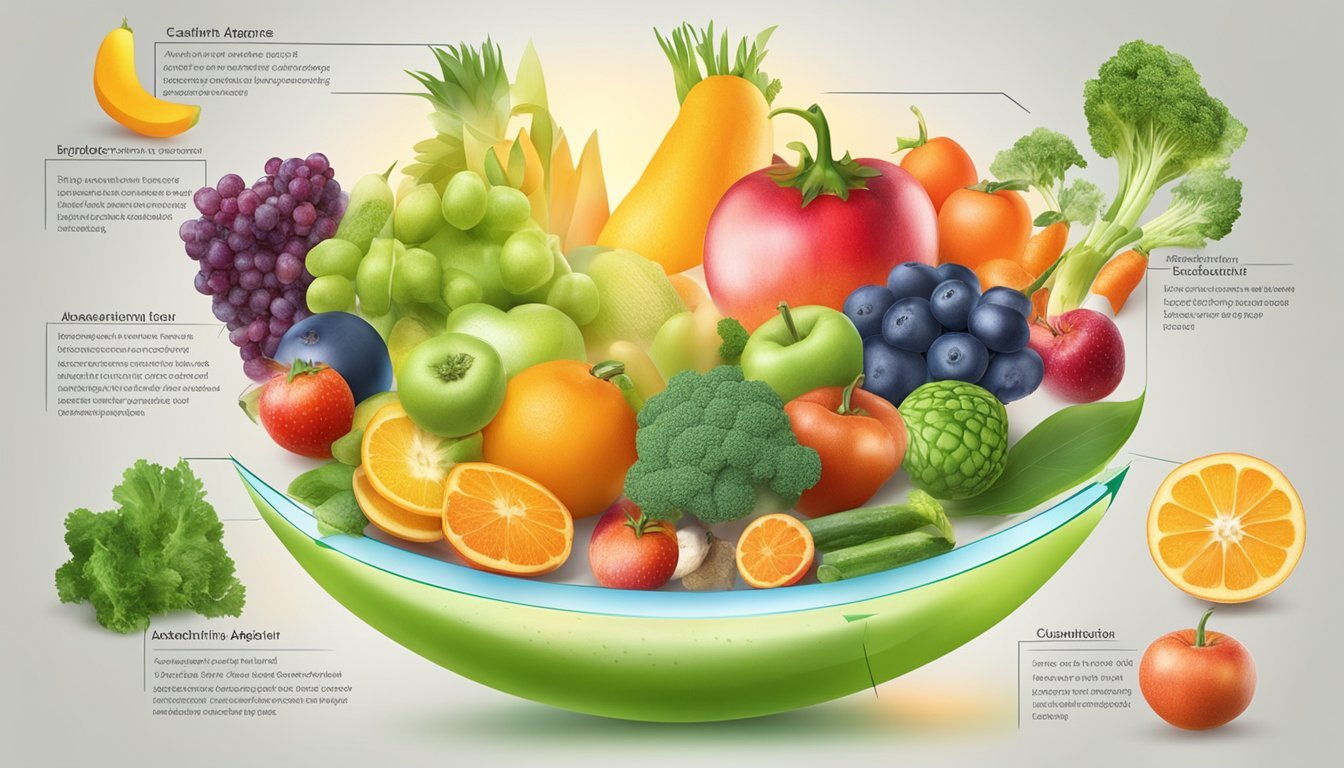Top 10 Foods Rich in Zeaxanthin for Eye Health
Top Sources for Eye Health
Zeaxanthin, a naturally occurring carotenoid, is crucial for maintaining healthy vision. Alongside lutein, it accumulates in the retina, particularly in the macula, where it acts as a protective shield against harmful light. Understanding which foods contain high levels of zeaxanthin can greatly benefit those looking to support their eye health naturally.
Incorporating foods rich in zeaxanthin into your diet can help bolster your visual acuity and possibly reduce the risk of age-related macular degeneration. These nutrients are most commonly found in various fruits and vegetables, making them accessible for anyone aiming to enhance their eye health through dietary choices.
1) Goji Berries
Goji berries are small red fruits known for their notable nutrient profile. They are particularly rich in zeaxanthin, a carotenoid that plays a crucial role in eye health.
Zeaxanthin in goji berries is highly bioavailable, which means it is readily absorbed by the body, enhancing its effectiveness. This makes goji berries a valuable dietary addition for those aiming to support their vision.
In addition to zeaxanthin, goji berries also provide a substantial amount of vitamin A, copper, selenium, and vitamin C. These nutrients collectively contribute to overall health and well-being.
Consuming goji berries may help protect against age-related macular degeneration and other eye diseases. Regular intake can improve macular pigments, which are essential for maintaining good vision.
Goji berries can be enjoyed in various forms, including fresh, dried, or as part of smoothies and cereals. Their versatility makes it easy to incorporate them into a daily diet for their zeaxanthin benefits.
2) Corn
Corn is a significant source of zeaxanthin, a carotenoid that contributes to eye health. This popular grain offers various nutritional benefits, including high levels of this essential pigment.
Consuming corn can aid in protecting vision. The zeaxanthin content helps in filtering harmful blue light and reducing oxidative damage.
From fresh corn on the cob to popcorn, there are multiple ways to incorporate this nutrient-rich food into the diet. Corn can be enjoyed boiled, grilled, or even added to salads and soups.
In addition to zeaxanthin, corn provides other nutrients such as fiber, vitamins, and minerals. This makes it a healthy and versatile choice for maintaining overall eye health and well-being.
3) Orange Bell Peppers
Orange bell peppers are a rich source of zeaxanthin, a powerful antioxidant. They are known for their vibrant color and sweet taste, making them a popular ingredient in a variety of dishes.
In addition to zeaxanthin, orange bell peppers also contain significant amounts of vitamin C and carotenoids. These nutrients contribute to maintaining good eye health and supporting the immune system.
Orange bell peppers can be consumed raw in salads, roasted as a side dish, or incorporated into stir-fries. Including them in your diet is an easy way to boost your intake of essential nutrients.
Their versatile flavor profile allows for creative culinary applications, making them a favorite among chefs and home cooks alike.
4) Kale
Kale stands out as one of the richest sources of zeaxanthin. This leafy green vegetable contains an impressive range of nutrients, making it a valuable addition to any diet. The dark green color of kale is a clear indicator of its high nutrient content.
Kale is particularly high in both lutein and zeaxanthin, which are beneficial for eye health. Consuming kale regularly can help support vision and may reduce the risk of age-related macular degeneration. These antioxidants work by protecting the eyes from harmful blue light and oxidative stress.
One cup of kale can provide a significant amount of zeaxanthin. Kale’s nutrient density makes it an excellent choice for those looking to boost their intake of these important carotenoids. Whether eaten raw in salads, cooked in dishes, or blended into smoothies, kale offers versatility and a robust nutrient profile.
Including kale in the diet is a simple way to increase the intake of zeaxanthin. This can be especially beneficial for individuals seeking to enhance their overall eye health and nutrient intake.
5) Spinach
Spinach is a powerhouse of nutrition and stands out as one of the top sources of zeaxanthin.
A cup of cooked spinach contains nearly 12 mg of lutein and zeaxanthin combined. These compounds are essential for eye health and can help reduce the risk of age-related macular degeneration.
Both raw and cooked spinach offer these benefits, though cooking can concentrate the nutrients. Incorporating spinach into daily meals can be an easy and effective way to boost zeaxanthin intake.
Spinach is versatile and can be added to salads, smoothies, and cooked dishes. It's not only rich in zeaxanthin but also provides other essential nutrients like vitamins A, C, and K.
6) Collard Greens
Collard greens are a significant source of zeaxanthin. This leafy green provides about 14.6 mg of zeaxanthin per cup when cooked.
These greens are also known for their high calcium and vitamin K content, which are important for bone health. A cup of cooked collard greens offers a substantial portion of daily fiber needs.
In addition to zeaxanthin, collard greens are rich in lutein, another vital carotenoid for eye health. Including these greens in one's diet can help protect the eyes from harmful high-energy light.
Eating collard greens regularly can be a beneficial addition to a balanced diet. They offer various nutrients that contribute to overall wellness without the need for excessive preparation or cooking.
7) Broccoli
Broccoli stands out as a potent source of zeaxanthin, contributing to its reputation as a nutrient-dense vegetable.
In addition to its zeaxanthin content, broccoli is rich in vitamins C and K, and dietary fiber. This makes it a versatile choice for various dishes while promoting overall health.
Raw broccoli delivers notable amounts of zeaxanthin. Cooking broccoli can affect its nutrient content, but steaming is a preferred method to preserve its benefits.
Broccoli's vibrant green color is a visual hint at its carotenoid content. Including broccoli in salads, stir-fries, or as a steamed side dish can help increase zeaxanthin intake.
8) Egg Yolks
Egg yolks are an excellent source of zeaxanthin. This carotenoid is essential for maintaining eye health and preventing conditions such as macular degeneration. The high fat content in egg yolks significantly enhances the absorption of zeaxanthin in the body.
Not only are egg yolks rich in zeaxanthin, but they are also packed with other vital nutrients. These include vitamin A, vitamin D, and various B vitamins. Incorporating egg yolks into the diet can therefore provide multiple health benefits.
For individuals looking to increase their zeaxanthin intake, consuming whole eggs is recommended. Scrambled eggs, omelets, or boiled eggs are simple and effective ways to enjoy the nutritional benefits of egg yolks.
Due to their bioavailability, the zeaxanthin in egg yolks is readily absorbed by the body. This makes them a highly efficient dietary source for this important nutrient.
9) Kiwi
Kiwi is a vibrant and nutritious fruit known for its high content of lutein and zeaxanthin. These carotenoids are beneficial for maintaining eye health and reducing the risk of macular degeneration.
In addition to being rich in these antioxidants, kiwi is also packed with vitamin C, vitamin K, and fiber. This makes it a small but mighty addition to anyone's diet.
Kiwi can be enjoyed on its own, added to fruit salads, or blended into smoothies. Its tangy flavor and numerous health benefits make it a popular choice among health-conscious individuals.
Including kiwi regularly in your diet is an excellent way to boost your intake of essential nutrients while also supporting your overall vision health.
10) Honeydew Melon
Honeydew melon is a sweet and refreshing fruit known for its high water content and pleasant taste. It is also a notable source of zeaxanthin, a carotenoid that plays a crucial role in eye health.
Eating honeydew melon can contribute to better eye health. This is due to the presence of zeaxanthin, which helps protect the eyes from oxidative stress and harmful light exposure.
Including honeydew melon in the diet can be an easy and delicious way to increase zeaxanthin intake. This fruit is often consumed fresh, added to fruit salads, or blended into smoothies.
Honeydew melons are also rich in vitamins and minerals. They contain vitamin C, potassium, and fiber, making them a healthy choice beyond just their zeaxanthin content.
Adding honeydew melon to your diet can be a convenient and tasty method to boost eye health and enjoy various other nutritional benefits.
What Is Zeaxanthin?
Zeaxanthin is a carotenoid with antioxidant properties. It plays a crucial role in maintaining eye health and offers additional health benefits.
Role In Eye Health
Zeaxanthin is essential for protecting the eyes from oxidative stress and harmful light. This carotenoid is found in high concentrations in the macula, the part of the retina responsible for central vision. Zeaxanthin helps filter out blue light, reducing the risk of age-related macular degeneration (AMD).
Foods rich in zeaxanthin that support eye health include:
Corn
Egg yolks
Orange peppers
Spinach
Kale
These foods can help maintain healthy vision and may reduce the progression of AMD.
Other Health Benefits
Apart from eye health, zeaxanthin offers additional benefits. It acts as an antioxidant, neutralizing free radicals and reducing inflammation. This can help lower the risk of chronic diseases such as heart disease.
Zeaxanthin is also known to support immune function. Including foods high in zeaxanthin in the diet may contribute to overall well-being and protection against certain health conditions.
Mechanism Of Action
Zeaxanthin plays crucial roles in the human body by protecting cells from oxidative stress and absorbing blue light. These mechanisms are vital for maintaining healthy vision and preventing damage to sensitive tissues.
Antioxidant Properties
Zeaxanthin acts as a powerful antioxidant, neutralizing free radicals and preventing cellular damage. Free radicals, which can result from environmental factors like UV exposure and pollution, can cause oxidative stress and damage cells.
This carotenoid is particularly effective in the eyes, where it protects retinal cells from oxidative damage. By absorbing excess light energy and quenching reactive oxygen species, zeaxanthin helps maintain the integrity of the retina. This function is important for preventing age-related macular degeneration and cataracts.
Light Absorption
Zeaxanthin is highly concentrated in the macula of the eye, where it filters high-energy blue light. This light filtration capability reduces the amount of blue light reaching the underlying retinal structures.
By absorbing blue light, zeaxanthin reduces phototoxic damage and enhances visual acuity. This process is crucial for maintaining sharp central vision and overall eye health. The macula's high concentration of zeaxanthin highlights its essential role in visual protection.
In summary, the ability of zeaxanthin to act as an antioxidant and absorb damaging blue light underlines its necessity in preserving vision and preventing retinal damage. The dual functions of protecting against oxidative stress and filtering blue light make zeaxanthin indispensable for eye health.







